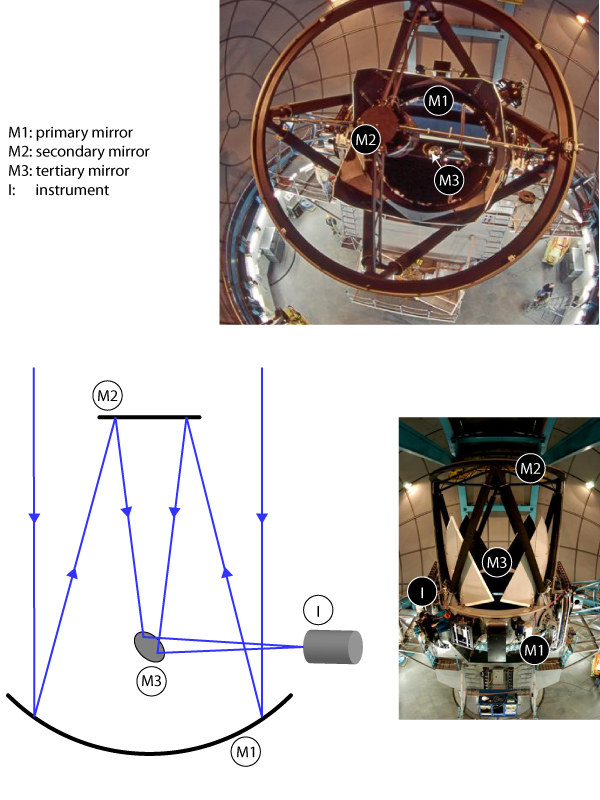Table with optical data for telescope and various instruments
|
The Enclosure
- Achieves precise heat control by means of forced ventilation through a small dome area, set above a small building.
- Unusually enclosed design promotes highly accurate telescope tracking through its control of wind buffeting.
- The building was designed in the US and constructed by local Chilean contractors.
- The dome was built in Brazil, using fiberglass panels from a US firm.
|
|
|
|
The mount and drives
- Built by Vertex-RSI Corp. in Texas
- Uses rolling element bearings for both altitude and azimuth
- Achieves high pointing and tracking specs
- Nominal telescope elevation limits: max = 88.5 deg; min=15 deg (we recommend working at elevations >20 deg. The ADC in the optical ISB can achieve 100% correction only down to 30 deg elevation. Below that, the correction will be only partial). Additional information on the current telescope elevation limits can be found here.
|
|
Optics
- Ritchey-Chrétien design, f/16.63
- 4.1m primary mirror made of Corning ULE glass
- Very high optical quality: 17 nm rms surface.
- Low thermal mass
- Primary mirror is 100mm inches thick
- Plate scale 0.330mm/arcsec or 3.025arcsec/mm
- Unobstructed field of view: 10 arcmin
- M1 curvature radius at vertex: -13.50970m
- M1 conic constant: -1.002667
- M2 diameter: 0.615m. Corning ULE glass
- M2 curvature radius: -2.03265m
- M1-M2 distance: 5.83922m
- M2-M3 distance: 4.98922m
- M3 to focus: 4250.0m
- Effective focal length: 68.175m (F/16.63)
- Focal surface radius: 0.9656m (convex outside)
- Central obscuration: 0.228 (diameter 936.5mm)
Active optics system
- 120-actuator control of primary
- Secondary on active hexapod
- Image analyzer permanently mounted at one instrument port.
Tip-tilt tertiary mirror
- Rapid tip-tilt correction at all foci
Features
Most instruments are permanently mounted:
- 2 Nasmyth clusters, 3 instruments each
- 3 Folded-cassegrain foci
- Rapid selection between instruments: ~60 seconds to switch
- At least two instruments are always ready, if requested beforehand
|
|
Visitor Instruments
If you have an interest in proposing to bring a visitor instrument, please contact the observatory directly beforehand. Waiting until the TAC process starts may be too late! General policies for visitor instruments are described here. A drawing of the Nasmyth instrument mounting locations is here; at present only the IR Nasmyth "straight port" is easily available for small visiting instruments.
Updated on July 5, 2022, 1:50 pm


